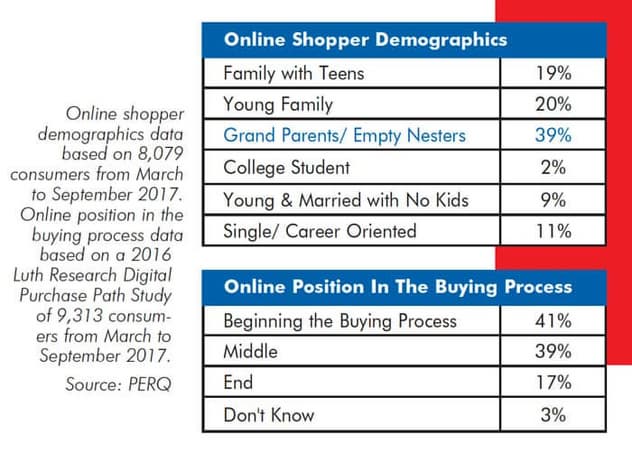
Engage this important group online by using incentives and calls to action. It's crucial to increasing store traffic and sales.
Like most online shoppers, Janet Dixon begins her search for new furniture by window-shopping on retail websites, doing online research on her options and current trends, and then planning a budget. The rural Indiana resident regularly posts on Facebook, communicates through Messenger and manages multiple email addresses.
No, she’s not a recent college grad or thirty-something professional. At age 62, Dixon represents the largest segment of shoppers in America: the Baby-Boom generation whose kids have grown up and moved out, leaving them with more money to spend on luxuries like high-end furniture.
Older Than You Think
Millennials replaced baby boomers as America’s largest living generation in 2016, inspiring many marketing and advertising strategies to shift focus to this group of online shoppers. Sure, Millennials know technology better than any previous generation and depend on Amazon and apps for daily life, but it’s really the Baby Boomers and Empty Nesters who drive the online shopping economy.
According to the data generated from PERQ's online guided shopping solution, nearly 40 percent of more than 8,000 consumers, using the platform from March to September 2017 identified themselves as grandparents or empty nesters — nearly double the size of any other group of shoppers.
In addition to our findings, KPMG’s 2017 Global Online Consumer Report further validated these statistics. Despite reasonable presumptions, Baby Boomers actually shop online just as frequently as Millennials. In the United States, Baby Boomers, on average, have around 15.1 transactions per person per year; while Millennials pull only slightly ahead with 15.6 transactions per person per year. As you can see, the difference is minimal.
More Money To Spend
In the Point/Counterpoint article in this issue, Bill Napier notes that consumers over 50 years old now account for more than half of all U.S. spending and will continue to be a major force in consumer spending in the coming decade.
Joey Gunn, vice president of Knight Furniture & Mattress in Texas, says there’s a huge overreaction to Millennials in the furniture advertising and marketing world. “At some point we’ll need to pay attention to them, but not yet,” says Gunn, who’s just a few years older than his Millennial counterparts and runs the business with his Baby Boomer father. “A lot of them still depend on their parents in some way, maybe not financially, but they’re getting hand-me-down furniture castoffs or even living with their parents.”

By contrast, Baby Boomers control 70 percent of our country’s disposable income and stand to inherit $15 trillion in the next 20 years, according to a study by The Nielsen Company & BoomAgers. Boomers often spend that extra money on furniture, especially as their kids move out and they remodel or redecorate.
Now, let’s briefly come back to Janet Dixon, the rural Indiana resident we mentioned before, and her husband. Since their two daughters moved out eight years ago, Dixon and her husband purchased guest bedroom furniture, a living room sofa, recliner, and a dining set big enough to seat their kids plus all five (soon to be six!) grandchildren in their newly remodeled kitchen. “The kitchen project was one I had wanted done for years,” Dixon says. “We were just too busy with the kids and activities, and it possibly didn’t fit into our budget before now.”
Online Sales Funnel
Dixon says she believes more of her peers than ever before are using the internet to shop, and she’s right. “Many of us have come up through the computer world, starting with big, huge computers that took up an entire room, to iPads,” she says. “We are not scared of technology and enjoy the convenience.”
As you can see, Millennials aren’t the only ones who are enamored with the convenience of technology. “There is a little Millennial in each of us,” says Mark Larson, Head of Consumer and Retail, KPMG in the US, in a 2017 report. “A number of Baby Boomers are starting to understand and appreciate the technology that is out there. They’re also trying to appreciate and experience the convenience of buying online.”

Furniture retailers are beginning to see how advantageous technology can be to their bottom line, too. Leveraging specialized software on their website, Knight Furniture was able to identify their target website audience as older online shoppers. “A lot of people engaging with our experience were identifying themselves as retired and grandparents. It was a little surprising to know that the folks who were engaging with us online were the same ones walking into our showrooms,” Gunn says.
Dixon agrees, ease of navigation plays a big role in which sites she uses for research. “Online shopping is only enjoyable when it is easy to navigate and I can go right to what I’m looking for without digging and searching through unrelated items,” she says.
That’s why technology and website tools that guide online shoppers along the sales funnel are so useful. By using interactive quizzes, promotions and calls-to-action to narrow customer searches, retailers can gather valuable data on each customer who visits their websites. Customers, in turn, can more easily find exactly what it is they’re searching for online.
Personal Service and Quality
In addition to valuing the convenience of technology, Baby Boomers really appreciate when a company takes the time to reach out with a personalized response. “The real magic comes when you’re engaging with them,” Gunn says.
“People are very cautious about giving out their information,” Gunn continues. “They expect if they do give you info, you won’t do any thing with it. If you turn around and surprise them with a personal email that’s directed at their experience online, that takes them by surprise. The older audience appreciates that much more than Millennials; they still appreciate the personal touch.”
Another thing Baby Boomers appreciate is quality furniture made in the U.S.A. Florida based furniture retailer, Hudson’s Furniture targets older shoppers since they’re overwhelmingly the largest demographic in the state. Company president Joshua Hudson says he’s learned a lot about what they prefer, and that means selling American name brands that consumers trust, along with keeping their website simple.
“We represent higher-end home furnishings and are not the low-price leader. The current Millennial is more attracted to disposable furniture and not in a place yet where they value nicer furniture,” Hudson says. “Where we do business, there’s no shortage of Baby Boomers and Gen X shoppers, so we’re fortunate we don’t have to focus on [Millennials] near as much as businesses in other parts of the country.”
Practical Steps
The driving force behind increasing online customer engagement for any demographic group, including the Empty Nesters, is to get more people to voluntarily give up personal information in return for receiving something they desire. This can be facilitated by offering incentives.
There are six elements you can focus on to increase website traffic and conversion, turning website visitors into leads for your furniture sales team. Here are two of these. The remainder will be addressed in a future article.
1. Unique Pattern Interrupt: This concept is simple. The more creative your Call-To-Action (CTA) that communicates something visitors desire, the better your results will be.
Ideally, you want to break visitors out of their normal pattern of browsing, causing them to stop and think, “What’s this?” Then brainstorm ways to tie their interest and attention into your brand message and the unique value you offer.
2. CTAs: It's critical to measure the effectiveness of your Calls-to-Action. They are the catalyst that generate online inquiries and sales. A few things you should review and improve continually in order to increase consumer engagement are:
- Traffic to Clicks Percentages on Each CTA: Track this metric to determine which CTAs are working and which are not? Adjust accordingly.
- Dynamic Design: Don’t settle for static and plain CTAs! Include animation on your banners,
buttons and sidebars.
- Language: Experiment with different ways to communicate your offers. Compare the effectiveness of each, measured by clicks and inquiries on your CTA.
- Colors: Colors have a huge impact on getting a CTA noticed. Use colors for your CTAs that fit your brand message, but also attract attention and get noticed.
- Options: Give customers options at each level of online engagement. Your website will attract visitors at each stage of the purchasing funnel, whether that’s browsing, researching or buying.
About Scott Hill: Scott Hill is the Executive Chairman and Co-Founder of PERQ, a consumer engagement company established in 2001. He’s passionate about making digital communication between business and consumers much more interactive. This led to the 2016 launch of PERQ’s Online Guided Shopping Solution, software designed to improve the online customer experience by making websites more personalized and interactive. PERQ’s solution is used on 600+ websites to enhance engagement and conversion, while increasing sales. Scott has launched two Inc. 100 companies and is a proud alum of Harvard Business School.
Five Ways To Cater To Empty Nesters
1. Use Technology to Your Advantage: Baby Boomers shop online far more frequently than most would expect. Integrate experiences, like quizzes, chat, calculators and appointment schedulers, to increase engagement on your website that actually help consumers narrow their purchasing decisions.
2. Older Online Shoppers Value Personal Service: People often expect that when they submit their information, nothing is done with it. Use the information you collect to personalize the experience for your consumers. Provide suggestions, answer questions and guide them.
3. Allow Them to Be Choosy: Baby Boomers prefer higher quality furniture. Give them some space, and allow them to be choosy before you go in for the hard sell.
4. Empty Nesters Have More Disposable Income: And now that they have disposable income, they’re willing to spend it. Provide them with copious amounts of different furniture options — including ones they may not have considered.
5. As Technology Evolves, So Do Baby Boomers: Never assume that Baby Boomers and Gen X’s are only “catching up” to Millennials. Despite preconceived notions, they’re moving just as fast as technology is evolving. Make sure you’re catering to these consumers every step of the way through every possible type of technological innovation possible.
About PERQ: PERQ’s Guided Shopping Solution leverages consumer behavior data to create a personalized experience for consumers on your home furnishings website. The interactive software, which integrates with retailers' existing websites, increases time on site, quality leads, and in-store and online revenue. Learn more at perq.com/furniture.
Furniture World is the oldest, continuously published trade publication in the United States. It is published for the benefit of furniture retail executives. Print circulation of 20,000 is directed primarily to furniture retailers in the US and Canada. In 1970, the magazine established and endowed the Bernice Bienenstock Furniture Library (www.furniturelibrary.com) in High Point, NC, now a public foundation containing more than 5,000 books on furniture and design dating from 1620. For more information contact editor@furninfo.com.